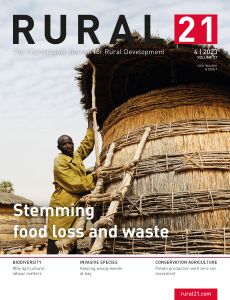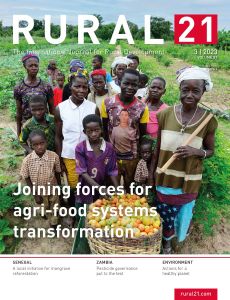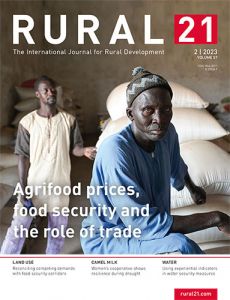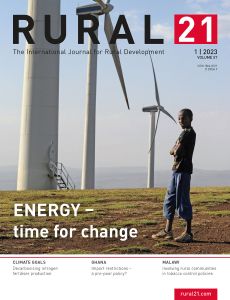Jahrgang 2023
-
Rural 21 (engl. Ausgabe 4/2023)
Focus 4/2023: Stemming food loss and waste
According to the latest progress report for the Sustainable Development Goals, about 8 per cent of all food produced in the world is lost on the farm, 14 per cent is lost between the farm gate and the retail sector, and 17 per cent is wasted at the retail, food service provider and household levels.
What is disturbing here is that these figures haven’t changed significantly in the past decade. Roughly 40 per cent of food still doesn’t get where it is meant to go, namely to the stomachs of the consumers. But hasn’t any progress at all been made in terms of food loss and waste? Or don’t we simply have any reliable methods to adequately assess the phenomenon? The answer is that both applies.
A recent study by the UK’s University of Greenwich arrives at the conclusion that food loss and waste measurements are usually aggregated from relatively small samples to national levels. This can result in volumes being considerably under- or overrated. Moreover, while we have a good knowledge of the problem in developed countries, above all of waste, little is known about that phenomenon in low- and middle-income countries. The question arising here is how to tackle a problem which can’t be properly measured.
While keeping these shortcomings in mind, we have asked our authors to present innovative, practical and, above all, scalable solutions from the fields they work in which can contribute to less food being wasted – for global food and nutrition security, for the economy, for the environment and for our climate.
Erfahren Sie mehr -
Rural 21 (engl. Ausgabe 3/2023)
Focus 3/2023: Joining forces for agri-food systems transformation
Our current agricultural and food systems are not capable of providing the global population with sufficient and healthy food within the planetary boundaries. Worse still, with their high freshwater consumption, their greenhouse gas emissions and their representing a threat to biodiversity, they destroy their very own ecological basis. The multiple crises of the last few years have added to all this, with the consequence that Sustainable Development Goal 2 – ending hunger by 2030 – will definitely not be reached.
It is generally agreed that our agricultural and food systems need fundamental changes – towards sustainability, resilience, health, equity and inclusiveness. But how can this best be achieved? Based on the global discourses of the past years and the initiatives emerging from them, our authors have identified key levers and cornerstones for successful agri-food systems transformation.
As can be expected, these vary depending on whether they reflect the view of politics, science or civil society. Nevertheless, consensus has been reached on many issues. The transformation pathways have to be systemic and cross-sectoral, and must break down complexity. They have to be locally owned, context-specific and include all stakeholder groups. They must regard trade-offs as inherent and create an acceptable compensation for the losers. And they have to contain short-, medium- and long-term activities. Based on experience gained in Ethiopia, Kenya, Rwanda and Tanzania, in Chile and Brazil, and in Bangladesh and Vietnam, our authors show what this can look like in practice.
Erfahren Sie mehr -
Rural 21 (engl. Ausgabe 2/2023)
Focus 2/2023: Agrifood prices, food security and the role of trade
Following the Russian Army’s invasion of Ukraine in late February 2022, food prices soared up world-wide in next to no time. Not only did the Food Price Index of the UN Food and Agriculture Organization reach an all-time high, fertiliser and energy prices leapt up across the world, too – with the well-documented consequences for food production and supply in many countries, above all in those of the Global South. That the wheat price has now, some 15 months later, returned to its pre-war level – despite the war’s going on and the Ukrainian grain exports having collapsed – shows that the world markets seem to be more resilient than expected.
In this edition, our authors take a look at the complex relations which – alongside the obvious shocks and crises – are behind price formation on the international agrifood markets. They analyse what triggered the major food price spikes in past years and how the food crises then and today differ from each other. Special attention is given to the role of speculation and the growing corporate concentration in the food chain, be it the seeds, farming machinery, agrochemicals or commodity trade sector.
Historically, there has been a pronounced correlation between international food and fertiliser prices. Our authors show what long-term fertilisation strategies could look like – strategies that make farmers and the economies independent of price developments on the international fertiliser markets and above all enhance the yields and labour productivity of smallholders.
Erfahren Sie mehr -
Rural 21 (engl. Ausgabe 1/2023)
Focus 1/2023: Energy – time for change
In addition to causing anxiety over global food security, Russia’s invasion of Ukraine has put the issue of energy security right at the top of the political agenda. In combination with a fear of supply bottlenecks, the dramatic fossil fuel price hikes have given new impetus to a transition to low-carbon energy sources – which is urgently needed anyway given global warming. In November last year, the International Energy Agency (IEA) announced that overall capacity of renewables is to almost double world-wide in the coming five years. Then these “clean” energy carriers could replace coal as the biggest source of electricity generation. From 2022 to 2027, the IEA is reckoning with power produced from renewable sources amounting to 2,400 gigawatts (GW) – a volume corresponding to China’s total power generating capacity. China, the USA and India are set to be the biggest drivers of renewable energy development, the IEA continues. And they are precisely the countries responsible for the largest shares world-wide of CO2 emissions (China: 33 %; USA: 13 %; India: 7 %). The latest edition takes a look at this change in global energy flows, the challenges which are currently emerging for Africa in particular in the energy sector and the role which the Global North plays in this context.
Erfahren Sie mehr






